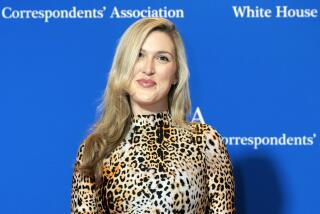New York Abuzz Over Bessie’s Mess : Romance, Politics, Intrigue Color the Case of Myerson, Miss America 1945
NEW YORK — The well-known political consultant was calling from a pay phone outside City Hall.
Try this story on for size, David Garth suggested:
“She’s tall, she’s beautiful, she’s one of the best-known people in the city, one of the most popular.
“She’s the first Jewish Miss America, and she’s also New York’s Miss America, in a sense. She’s the personification of the combination of brains, beauty, intelligence and career that so many women strive for.”
He plunked another quarter into the machine.
“Then she gets involved in a very romantic and painful love affair with someone who was born the year she won Miss America.” Garth paused. “If I said to you, ‘Write this book and here’s the outline,’ you’d say no one would buy this story.”
Nonetheless, perfectly sane people were coughing up perfectly good money to buy magazines and newspapers that were filled with the story of the “fall” of the woman known as Queen Bess or Bessie From the Bronx.
Hard on the pedicured heels of Donna Rice, Bess Myerson--Miss America 1945--found herself on the cover of People magazine.
At least one New York publisher, Newmarket Press, was wagering that the interest in Myerson would translate into sales of a book commissioned a year and a half ago and due out in October.
Over cocktails, at lunch and in the subway, New Yorkers turned their tongues from the Ballad of Bernhard Goetz to the Tale of the Myerson Mess.
Replay, but Heavier
“It’s a replay: Miss America goes bad,” one New Yorker said, likening the controversy surrounding this city’s former commissioner of cultural affairs to the Vanessa Williams scandal of 1984.
“Except,” this one-time City Hall power broker added carefully, “this one’s got a far heavier piece of business attached to it.”
The publication of revealing photographs of the first black Miss America forced Williams to resign her title in a cloud of embarrassment. But daily disclosures about the activities and involvements of Myerson--from reports of strange, chauffeur-driven drop-offs of fat envelopes filled with money to dogged harassment of an ex-boyfriend who spurned her--have some in this city’s power structure at once clucking in amazement and groaning at possible ramifications.
“What makes it interesting in New York is the potential that she could bring down Koch, and no one else has been able to do that yet,” said a public relations executive who once worked for an opponent of New York Mayor Edward I. Koch.
A Worrisome Link
“What worries people at City Hall the most,” he said, “is that Bess is linked with Koch in the entire public mind, not just in the minds of the political insiders.”
Political consultant Garth, long a Koch insider, agreed: “It’s going to hurt the mayor in the sense that she is personally close to him.
“But the tragedy in this thing is a personal love affair.”
Accused of “serious misconduct” in improperly influencing a New York judge on behalf of her longtime companion, 62-year-old Myerson was forced to step down in April from the $83,000-a-year cultural affairs commissionership here.
Since then, there have been allegations that Myerson hired the daughter of state Supreme Court Justice Hortense W. Gabel in exchange for Gabel’s leniency in the divorce case of Myerson’s boyfriend, contractor Carl A. Capasso. And they have been compounded by evidence that Myerson engaged in what Koch has termed “erratic” behavior seven years ago after the breakup of another relationship.
In that case, a report to Koch in 1980 showed that Myerson made abusive telephone calls and sent anonymous letters to the financial investor with whom she had been involved. Dismissing the matter as “personal” and “a lovers’ quarrel,” Koch chose to overlook the police report on Myerson and in 1983 named his old friend and political supporter to the cultural commission.
Myerson had earlier served as New York City’s commissioner of consumer affairs, and later worked as a consumer commentator for a New York television station. In 1980, she made an unsuccessful run for the Senate as a Democrat from New York.
What Koch has called Myerson’s “fall from grace” from the cultural affairs position began last winter in the wake of an investigation into the business practices of Capasso.
Myerson invoked the Fifth Amendment on that matter in an appearance before the federal grand jury in Manhattan. Capasso, 41, pleaded guilty to tax evasion in January and was fined $500,000. He is serving a four-year prison term on those charges.
For Myerson, the matter was further complicated when an investigation showed she had hired Gabel’s daughter, Sukhreet, as a special assistant. Gabel later sliced Capasso’s weekly alimony payments from $1,500 to $500. Myerson and Capasso had been linked romantically for several years.
Almost daily, new information in the Myerson case surfaces. Responding to reports that Myerson deposited large manila envelopes filled with money at a Manhattan stock brokerage house, for example, a federal grand jury late last week issued a subpoena to the firm to obtain records of those alleged transactions.
The Koch Connection
Comparisons inevitably surfaced to the scandals swirling persistently around the Koch Administration, where corruption charges inside City Hall are as common as jaywalkers outside.
In recent months, such allegations have forced the ousters of New York’s transportation commissioner, taxi commissioner and the former president of the city’s hospital system. A scheme involving the Parking Violations Bureau and a plan to sell city contracts was believed to be one of the reasons the Queens borough president committed suicide last year. Another close adviser to Koch quit in ignominy after admitting that he falsified his academic credentials.
One reason the Myerson matter has piqued such interest, a longtime observer of New York politics contended, is that until now, “Koch has somehow remained relatively unscathed.”
But last week’s revelations about Myerson and her ex-boyfriend made some people wonder what surprise would be next.
“Bess does not go gentle into that good night, if you look at her past history,” the same political observer remarked.
Still, for one small New York publishing house, the debacle of the former Miss America promised to serve as a possible boon.
Long before the furor erupted over Myerson, Newmarket Press had envisioned Susan Dworkin’s “Miss America 1945: Bess Myerson’s Own Story” as an important title among the five books Newmarket will publish this fall. Though the book will not address the current flap, the tiny publishing house is anticipating renewed interest in the once-aspiring concert pianist who rose from the Bronx to national prominence.
“I think people are going to be curious about her, obviously more than they would have been a year and a half ago,” said Esther Margolis, Newmarket’s president and publisher.
Biography, Cultural History
More than 18 months ago, Margolis began organizing the project she calls “part biography and part cultural history.”
The book is a “collaborative effort,” Margolis said, based on extensive interviews with Myerson and written “with the cooperation of Bess.” Though bearing the name of novelist/playwright/nonfiction writer Dworkin on its cover, “Bess’ voice is throughout the book,” Margolis said.
As Margolis conceived it, the book was to deal equally with Myerson, the Miss America phenomenon and 1945, “which I believe is a watershed time, really, a very pivotal year in America.”
For one thing, “the image of the female was changing at that time,” Margolis said. That “was the year in which women were told to go back to the home, after they had spent the war years working in the plants.”
The 1945 Miss America pageant, Margolis said, “happened two months after the first concentration camps were liberated.”
“It was a very uncommon time, and she was an uncommon woman,” she said.
Margolis said Dworkin’s interviews with “more than 100 people” confirmed popular mythology that Myerson was entered in her first beauty contest by her older sister Sylvia. The lure was the prospect of an academic scholarship, the first year such a plum was offered by the Miss America contest.
“In 1945, you couldn’t get a scholarship unless you were a returning veteran,” Margolis said. “Bess had just graduated from Hunter College and very much wanted to continue her music studies, possibly to become a conductor.”
Though urged to change her name to “Beth Merrick,” a name thought to be less culturally identifiable, Myerson won the title in her own name. Sheltered until then in a tight community of Russian Jewish immigrants in the Bronx, Myerson has said she was stunned to encounter anti-Semitism in the course of her duties as Miss America.
But for many people, Margolis said, Myerson “has been in many respects an idol.” The current uproar over Myerson “certainly has made people sad,” she said.
‘Cheering for Her’
Garth, a close friend of Myerson who said she introduced him to the mayor, agreed.
“There are a lot of people with silver hair who are out there cheering for her,” he said. “I think people look at this as a sad thing: ‘Too bad about Bess Myerson.’ ”
At week’s end, Myerson was reported to be “close to her family,” one acquaintance said.
“She’s not going to be available for any comment,” Myerson’s lawyer, Fred Hafetz, said.
In Atlantic City, N.J., an unidentified spokesman for the Miss America pageant declined to discuss the Myerson matter.
At Newmarket Press, Margolis was hesitant to speculate about what many see as Myerson’s professional demise.
“I can’t say that,” Margolis said. “We all bear the seeds of our past.”
Sad and even sordid as it may be, the story continued to fascinate many New Yorkers.
“Like a good novel,” the former City Hall insider said, “it’s still a page-turner.”
More to Read
Sign up for our Book Club newsletter
Get the latest news, events and more from the Los Angeles Times Book Club, and help us get L.A. reading and talking.
You may occasionally receive promotional content from the Los Angeles Times.







